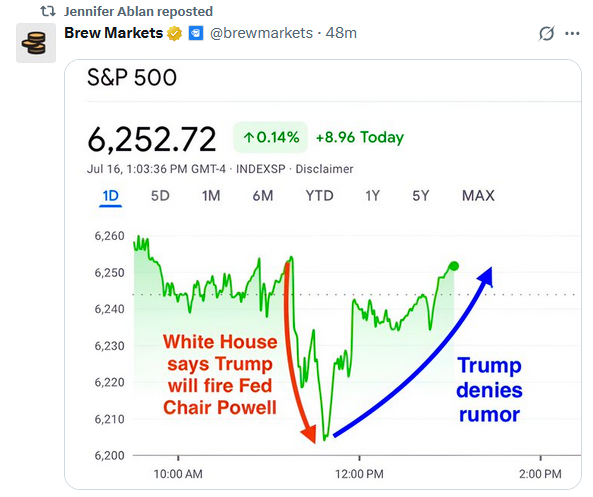It appears President Donald Trump set a test for the market to see what investors would think of him firing Jerome Powell. The bond and stock markets provided a swift answer to Trump’s test. The test originated inconspicuously from a post on X by Florida Republican Anna Paulina Luna, who had been on the phone with Trump earlier that day. She tweeted the following in regards to Powell: “I’m 99% sure firing is imminent.”
Minutes later, Bloomberg ran an article entitled: Trump Likely to Fire Powell Soon, White House Official Says. futures, as shown below, fell by nearly 1.5 points as the rumors quickly spread through the market.
About an hour after the rumor started, Trump put an end to the test and reversed the adverse market reaction by saying:
I don’t rule out anything, but I think it’s highly unlikely, unless he has to leave for fraud.
Trump is very sensitive to market reactions and already believes that are too high. If he were to take the unprecedented action of firing Jerome Powell, interest rates could move higher, as we just got a preview of.
Therefore, the rumor and rebuttal may have been a carefully choreographed action to judge how the bond market would react. Based on the sharp decline in bond prices, the answer is not very good. As we share below in today’s Tweet of the Day, the stock market reaction was similar to the bond market. 
Private Assets And Your 401K
According to Bloomberg, an industry group is attempting to make private equity and debt investments an option in 401(k) plans. The leaders of the industry group happen to be the firms that generate massive profits from running private equity/debt funds. The group is selling these riskier investments as a democratization of the capital markets.
In other words, Mom and Pop investors can now access what was previously the domain of institutional and high-net-worth investors. The key for the group is to ensure that private investments meet the fiduciary guidelines required of 401K plans.
Private assets do tend to produce higher returns in large part because they are less liquid. However, with reduced liquidity comes risk. In addition to higher levels of risk comes disingenuous claims of low volatility. Unlike stocks and bonds, which have a current price at all times, many private assets are only priced once a quarter or even yearly.
Furthermore, the prices are often very subjective. Thus, while the price of private assets may appear less volatile than that of stocks or bonds, the actual value of the asset may be significantly more volatile.
We think there is plenty of value in private assets, and for some individuals, investments in such assets may be worthwhile. However, with the chase to “democratize” private assets comes higher prices/lower prospective returns. Warren Buffett once said, “Price is what you pay, value is what you get.” When assets get extended, as we are seeing in some private equity sectors, investors are paying higher prices in exchange for less value.
Tweet of the Day

